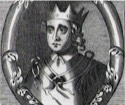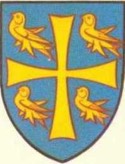Snyder Family 2016 - Person Sheet
BirthBET ABT 934 AND 944
Death8 Jul 975, Winchester, England
Death Memoage 41
BurialGlastonbury Abbey, Somerset, England
FatherEdmund I "The Magnificent" King of England (921-946)
MotherÆlfgifu , Queen Of England (896-944)
Spouses
Death965, Wilton Abbey, Wiltshire, England
Marriageabt 961
ChildrenÆthelred II "The Unready" (~968-1016)
Marriageabt 961
ChildrenEdward II “The Martyr”, King of England (963-979)
Notes for Edgar I "The Peaceable" King of England
AKA: Eadgar I King Of The English
b. 934/944 / d. 8 Jul 0975, Winchester, England, Age: 41
br. Glastonbury Abbey, Somerset
E D G A R
(959-75 AD)
Edgar was made King of Mercia and Northumbria in 957 and succeed to the throne of Wessex at his brother, Eadwig's, death in 959. With this, Edgar was King of Mercia, Northumbria and Wessex (the three most powerful kingdoms in England at that time), simultaneously and could be considered the first ruler of a United England. Some of his predecessors were Kings of All England by virtue of being King of Wessex and, at the same time, enjoying a temporary military ascendancy over the other kingdoms.
He was formally crowned in 973 and received the ceremonial submission of all the other kings in Britain. He wisely recalled (St.) Dunstan from exile and made him Archbishop of Canterbury and his closest personal advisor. His reign was prosperous and peaceful and he is generally credited with the revival of the English church.13
---------------
3Edgar I the Peaceful or the Peaceable (c. 7 August 943–8 July 975) was a king of England.
Edgar was the younger son of Edmund I of England. His cognomen, "The Peaceable", was not necessarily a comment on the deeds of his life, for he was a strong leader, shown by his seizure of the Northumbrian and Mercian kingdoms from his older brother, Edwy, in 958. A conclave of nobles held Edgar to be king north of the Thames, and Edgar aspired to succeed to the English throne. Upon Edwy's death in October 959, Edgar immediately recalled Dunstan (eventually canonised as St. Dunstan) from exile to have him made Bishop of Worcester (and subsequently Bishop of London and Archbishop of Canterbury). The allegation Dunstan at first refused to crown Edgar because of disapproval for his way of life is a discreet reference in popular histories to Edgar's abduction of[citation needed] Wulfthryth, a nun at Wilton, who bore him a daughter Eadgyth. Dunstan remained Edgar's advisor throughout his reign.
Though Edgar was not a particularly peaceable man, his reign was a peaceful one. The Anglo-Saxon kingdom of England was at its height. Edgar consolidated the political unity achieved by his predecessors. By the end of Edgar's reign, England was sufficiently unified that it was unlikely to regress back to a state of division among rival kingships.
The Monastic Reform Movement that restored the Benedictine Rule to England's undisciplined monastic communities peaked during the era of Dunstan, Aethelwold, and Oswald. (Historians continue to debate the extent and significance of this movement.)
Edgar was crowned at Bath, but not until 973, in an imperial ceremony planned not as the initiation, but as the culmination of his reign (a move that must have taken a great deal of preliminary diplomacy). This service, devised by Dunstan himself and celebrated with a poem in the Anglo-Saxon Chronicle, forms the basis of the present-day British coronation ceremony. The symbolic coronation was an important step; other kings of Britain came and gave their allegiance to Edgar shortly afterwards at Chester. Six kings in Britain, including the kings of Scotland and of Strathclyde, pledged their faith that they would be the king's liege-men on sea and land. Later chroniclers made the kings into eight, all plying the oars of Edgar's state barge on the River Dee. Such embellishments may not be factual, but the main outlines of the "submission at Chester" appear true. (See History of Chester.)
Edgar died on 8 July 975 at Winchester, and was buried at Glastonbury Abbey. He left two sons, the eldest named Edward, the son of his first wife Ethelfleda (not to be confused with Ethelfleda, Lady of the Mercians), and Ethelred, the youngest, the child of his second wife Ælfthryth. He was succeeded by his eldest son, Edward. Edgar's illegitimate daughter Eadgyth became a nun at Wilton and was eventually canonised as St. Edith.
From Edgar’s death to the Norman Conquest there was not a single succession to the throne that was not contested. Some see Edgar’s death as the beginning of the end of Anglo-Saxon England, followed as it was by three successful 11th-century conquests — two Danish and one Norman.
b. 934/944 / d. 8 Jul 0975, Winchester, England, Age: 41
br. Glastonbury Abbey, Somerset
E D G A R
(959-75 AD)
Edgar was made King of Mercia and Northumbria in 957 and succeed to the throne of Wessex at his brother, Eadwig's, death in 959. With this, Edgar was King of Mercia, Northumbria and Wessex (the three most powerful kingdoms in England at that time), simultaneously and could be considered the first ruler of a United England. Some of his predecessors were Kings of All England by virtue of being King of Wessex and, at the same time, enjoying a temporary military ascendancy over the other kingdoms.
He was formally crowned in 973 and received the ceremonial submission of all the other kings in Britain. He wisely recalled (St.) Dunstan from exile and made him Archbishop of Canterbury and his closest personal advisor. His reign was prosperous and peaceful and he is generally credited with the revival of the English church.13
---------------
3Edgar I the Peaceful or the Peaceable (c. 7 August 943–8 July 975) was a king of England.
Edgar was the younger son of Edmund I of England. His cognomen, "The Peaceable", was not necessarily a comment on the deeds of his life, for he was a strong leader, shown by his seizure of the Northumbrian and Mercian kingdoms from his older brother, Edwy, in 958. A conclave of nobles held Edgar to be king north of the Thames, and Edgar aspired to succeed to the English throne. Upon Edwy's death in October 959, Edgar immediately recalled Dunstan (eventually canonised as St. Dunstan) from exile to have him made Bishop of Worcester (and subsequently Bishop of London and Archbishop of Canterbury). The allegation Dunstan at first refused to crown Edgar because of disapproval for his way of life is a discreet reference in popular histories to Edgar's abduction of[citation needed] Wulfthryth, a nun at Wilton, who bore him a daughter Eadgyth. Dunstan remained Edgar's advisor throughout his reign.
Though Edgar was not a particularly peaceable man, his reign was a peaceful one. The Anglo-Saxon kingdom of England was at its height. Edgar consolidated the political unity achieved by his predecessors. By the end of Edgar's reign, England was sufficiently unified that it was unlikely to regress back to a state of division among rival kingships.
The Monastic Reform Movement that restored the Benedictine Rule to England's undisciplined monastic communities peaked during the era of Dunstan, Aethelwold, and Oswald. (Historians continue to debate the extent and significance of this movement.)
Edgar was crowned at Bath, but not until 973, in an imperial ceremony planned not as the initiation, but as the culmination of his reign (a move that must have taken a great deal of preliminary diplomacy). This service, devised by Dunstan himself and celebrated with a poem in the Anglo-Saxon Chronicle, forms the basis of the present-day British coronation ceremony. The symbolic coronation was an important step; other kings of Britain came and gave their allegiance to Edgar shortly afterwards at Chester. Six kings in Britain, including the kings of Scotland and of Strathclyde, pledged their faith that they would be the king's liege-men on sea and land. Later chroniclers made the kings into eight, all plying the oars of Edgar's state barge on the River Dee. Such embellishments may not be factual, but the main outlines of the "submission at Chester" appear true. (See History of Chester.)
Edgar died on 8 July 975 at Winchester, and was buried at Glastonbury Abbey. He left two sons, the eldest named Edward, the son of his first wife Ethelfleda (not to be confused with Ethelfleda, Lady of the Mercians), and Ethelred, the youngest, the child of his second wife Ælfthryth. He was succeeded by his eldest son, Edward. Edgar's illegitimate daughter Eadgyth became a nun at Wilton and was eventually canonised as St. Edith.
From Edgar’s death to the Norman Conquest there was not a single succession to the throne that was not contested. Some see Edgar’s death as the beginning of the end of Anglo-Saxon England, followed as it was by three successful 11th-century conquests — two Danish and one Norman.
Notes for Aethflaeda The Fair (Spouse 2)
Married CIR 961 to , AEthelflaeda the Fair



